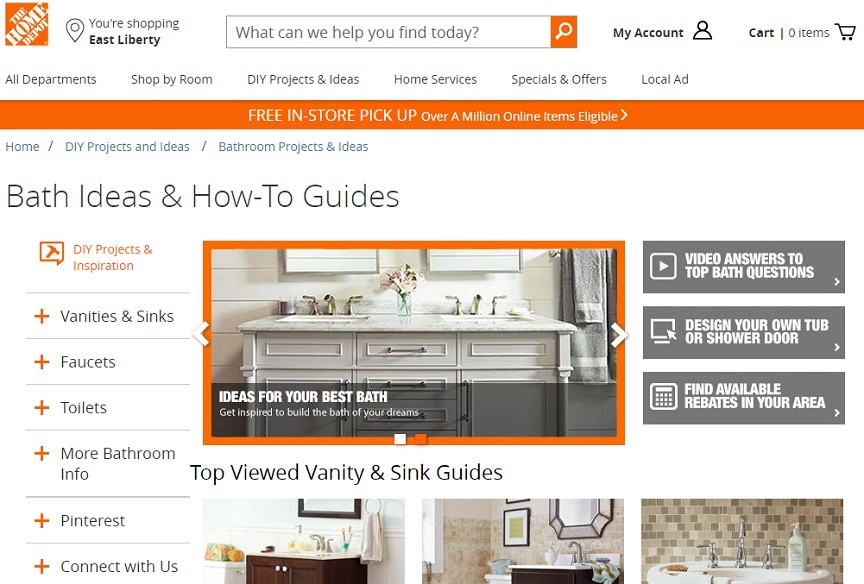How Web Design Impacts Content Marketing
The design a company chooses impacts how a potential consumer perceives them. From color choice to style, different elements add up to create a first impression.
This means that bad design – or lack of design – can have potential customers closing the browser and seeking other businesses. As a result, your company’s design can affect several components of your digital marketing strategy, and this is especailly true of content marketing.
What is content marketing?
Content marketing is the practice of publishing content that does not directly advertise a company’s product or brand, but generates interest in those things by providing relevant and helpful information.
For example, Home Depot has an entire section on their site dedicated to DIY projects and ideas, where they publish guides and tutorials to help homeowners make simple repairs themselves instead of hiring a contractor or other professional.

It provides homeowners with the information they needed to make repairs on their own, and is broken down into different rooms in the house and categorized by types of improvement, like electrical and plumbing.
Although these guides aren’t straightforward advertisements, the visitors who read them are likely more inclined to purchase the required supplies from Home Depot, rather than a competitor. The association of the guidebook – and helpful information – with Home Depot opens the door to the possibility of sales.
How web design impacts content marketing
Although these guides are primarily driven by content, Home Depot’s web design impacts how users access and read them.
Accessibility
One of the most important considerations in designing a content-heavy site is accessibility. If you publish informational content on your site, it needs to be easy to find and read. Your navigation should allow users to find the information they want, without clicking through pages of irrelevant content.
If a visitor has to dig through page after page to get to the information they’re searching for, they’ll be likely to give up and visit another site instead. Creating a straightforward navigation setup with drop-down menu choices is a great way to help visitors to find what they are seeking and access it quickly.
Appearance
Visitors will make judgements about the quality and trustworthiness of your content based on how professional your site looks. Even if your content is easy to find, the design can turn people away.
If your site looks outdated or is visually unappealing, users may be hesitant to consider you a valuable resource. You need to have a clean design that illustrates your professionalism, and gives visitors confidence that they can trust your advice.
Readability
Along with the overall look of your site, your text should be visually appealing and easy to read. Too many fonts can be overwhelming and unprofessional, and you can typically stick to one font for titles and another for body copy.
Choosing the right fonts and colors is essential for helping your visitors read and comprehend your content. You might publish the most helpful content available on a specific topic, but if your font color is too similar to your background, your visitors may not even bother to read it.
Your body copy also needs to be clean and large enough to be read without struggle. These details all seem minor, but can have a major impact on how effective your content marketing strategy is with potential customers.
Comprehension
Many people are visual learners, and need graphics and photos to fully understand new topics and information. This means it’s essential to include visuals with all of your content.
For example, one popular type of online content today is quick cooking videos with directions and ingredients for a simple recipe.

People who watch these videos learn exactly how to make the meal or snack being shown, which makes it easier for them when they decide to try the recipe out for themselves.
Regardless of your industry, visual content like photos and videos can help your potential customers get a better idea of how they can use your products or services. From a design standpoint, this means that your site’s layout should work well with visual content, and make it easy for readers to scroll through photos and watch videos.
Designing a content-friendly site
There are many different web design elements that play a role in content marketing, but the bottom line is that your site should be designed with your visitors and readers in mind. The easier it is for your visitors to find what they’re looking for, and the more enjoyable it is for them to read your content, the better results you’ll see from your strategy.
The post How Web Design Impacts Content Marketing appeared first on WebFX Blog.